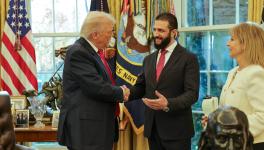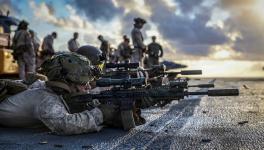Iran Shooting Down Spy Drone in its Airspace is Resistance to US Aggression
Image released by the Iranian Revolutionary Guard Corps of the shooting down of the US spy drone (Photo: IRNA)
The situation in the Persian Gulf region is deteriorating with each passing hour. On Thursday, the Iranian Revolutionary Guard Corps (IRGC) shot down a US Global Hawk Surveillance drone inside Iranian territory. Though the United States initially denied it, they eventually had to confirm it. This was immediately followed by president Trump ordering an attack on several military targets in Iranian territory. The attack orders were on until late in the evening yesterday, with US ships and planes having locked their targets and ready to strike, only to be abruptly called off at the last minute. This was possibly the closest to a full-blown war that the United States has pushed Iran into, ever since the Iranian Revolution.
Over the past two months, the US has been escalating the war industry and preparing for an invasion of Iran. Acting US Secretary of Defence Patrick Shanahan confirmed the deployment of over a 1,000 extra troops to the region. This was announced by Trump on Monday, June 17. Shanahan argued that these troops are deployed in order to “ensure the safety and welfare of our military personnel working throughout the region to protect our national interest.” This is the second time that US has sanctioned a massive deployment of troops in the region, this year. In the last month Trump administration had already deployed 1,500 troops and an aircraft carrier in the region in May. The US already has around 70,000 troops across the Middle East, under various commands.
Yesterday’s escalation has largely to do with the espionage incursion through a drone that Iran has accused the US of. As per the IRGC, which has been declared a “global terrorist group” by the US recently, the drone was shot down in the district of Kouh Mobarak in the coastal province of Hormozgan. The US central command denied this and claimed that a US navy drone, MC 4C Triton, was shot down by the Iranian surface to air missile in international airspace.
The Tasnim News Agency quoted the secretary of Iran’s Supreme National Security Council saying that the incident happened well within the Iranian territories and it was a spy drone. According to him, “our airspace is our red line and Iran has always responded and will continue to respond strongly to any country that violates our airspace.”
Manufacturing a war narrative
Aggressive media campaign has been undertaken by the US Secretary of State Mike Pompeo and other US allies in the region, including Saudi Arabia, holding Iran responsible for the attacks on the ships in the Persian Gulf. Both Pompeo and Saudi Arabia allege that Iran was behind both the attacks on tanker ships, on June 13 and May 12. In both the cases, allegations were made against Iran without any credible evidence, while Iran’s offer to cooperate in an independent inquiry has been ignored.
The reiteration of these unfounded allegations has only compounded to the tensions further. After the release of a grainy video on June 19, the US navy claimed that they have recovered fragments from the tankers attacked on June 13. These fragments “bore striking resemblance to mines seen during military parades”, Al Jazeera reported. Iranians call such claims dubious and a part of the larger sabotage diplomacy led by the likes of John Bolton, Benjamin Netanyahu, Mohammed Bin Salman and Mohammed Bin Zayed al Nahyan.
The unfolding of imperialist designs
In the view of the larger geopolitics of the region, these are signs of a deliberate gradual build up against Iran. American and Saudi attempt is to isolate Iran though unsubstantiated allegations of aggression in order to justify its own imperialist aggression in the region.
Vijay Prashad in an article explained how the warmongering is a part of a larger strategy designed by the Iran Mission Center, supported by the infamous US espionage group Central Intelligence Agency. According to him, Iran Mission Center directly works under John Bolton and headed by a CIA officer, Michael D’Andrea. The works of the Mission is supported by billionaires Thomas Kaplan and America’s Arab allies.
Meanwhile, in a statement issued by the US State Department, its Iran representative Brian Hook will be visiting the region to meet officials from Saudi Arabia, UAE, Oman, Kuwait and Bahrain, and discuss “Iran’s regional aggression”. The regional aggression is a reference to the alleged Iranian influence over the Ansar Allah (commonly known as the Houthis) in Yemen and the Hezbollah in Lebanon. Iran is also alleged to be aiding the Hamas in Gaza.
Iran is also seen as an emerging military ally of Iraq and Syria. All these regions, suffering from conflicts mostly supported or led by the US or its regional allies, are considered significant for the regional imperialist designs. Any sign of a rise of Iranian influence is considered as a threat, as it can counterbalance US hegemony in the region denying imperialist powers a free hand over the rich resources.
Economics of warmongering
Donald Trump’s election campaign of “Make America Great Again” largely stood on the promise of reviving the economy and of bringing jobs ‘back’ to the US. Somewhere over there seems to have been a realisation that these promises may not be possible in the short run. Conflict and insecurity have its own economic logic. GCC nations (Gulf Cooperation Council) have been among the largest buyers of US weapons, having participated in different conflicts in the region.
Rise of a competitor, who refuses to be co-opted, seems to be primarily behind the Trump administration’s actions that have deliberately escalated tensions. Trump is ready to risk another war in the region despite the promise of withdrawing from “endless wars”, being another one of his campaign planks.
The failure of the ‘global community’, yet again
The fresh sanctions on Iran imposed last year and intensified since then were initially seen enough to pressurise Iran to withdraw from its regional engagements. However, this has not come out as expected. Iran has refused to give in to these aggressive measures, having called it economic terrorism and want other signatories of the Joint Comprehensive Plan of Action, namely France, UK, Germany, Russia and China, to pressurise the US to uphold its end of the bargain.
However, the motivations and capability of these signatories powers in persuading or standing up to the US also needs to be reflected upon. The European powers do not see any reason in antagonising the Trump administration at this juncture. So, they want Iran to maintain restraint.
On the other hand, Russia and China have limited influence over current American administration. China is itself facing a trade war with the US and would not like to open another front, at least not directly. There is no credible channel of communication between Russia and the US, at the moment, for the former to mediate on the behalf of Iran.
Major third world countries like India, once a proud leader of the large Non-Aligned Movement which played limited yet effective role in the international politics, have already been co-opted by the US. India was one of the first countries which offered to follow the sanctions regime against Iran, despite the adverse effects it is going to have on its own economy. Turkey may only oppose the sanctions in rhetoric, but has not demonstrated any willingness to take concrete measures and sacrifice its prised position as a NATO member, over Iran.
The history of post-colonial world politics has several such instances where imperialist forces used all kinds of tactics to achieve their goals of uninterrupted interest maximisation. They do not like to be pushed into treating others as their equals, much less be challenged. Iran story has come to be quite similar to nations like Venezuela, Cuba and North Korea, who have paid dearly for standing up to imperialism.
But considering the Islamic Republic’s prominence and place in the region politics and its strategic geography, implications and fallout of a war on Iran is going to be even larger than any other nation that has been resisting US aggression. Apart from pushing an already war-torn and strife-ridden region into a protracted and disastrous conflict, it might push other far off global powers like China and Russia to be directly involved.
It is still unknown what brought the Trump administration to call off an attack on Iran. Did better sense prevail within the administration? Or is it just a postponement for an even bigger and better planned attack?
Get the latest reports & analysis with people's perspective on Protests, movements & deep analytical videos, discussions of the current affairs in your Telegram app. Subscribe to NewsClick's Telegram channel & get Real-Time updates on stories, as they get published on our website.























